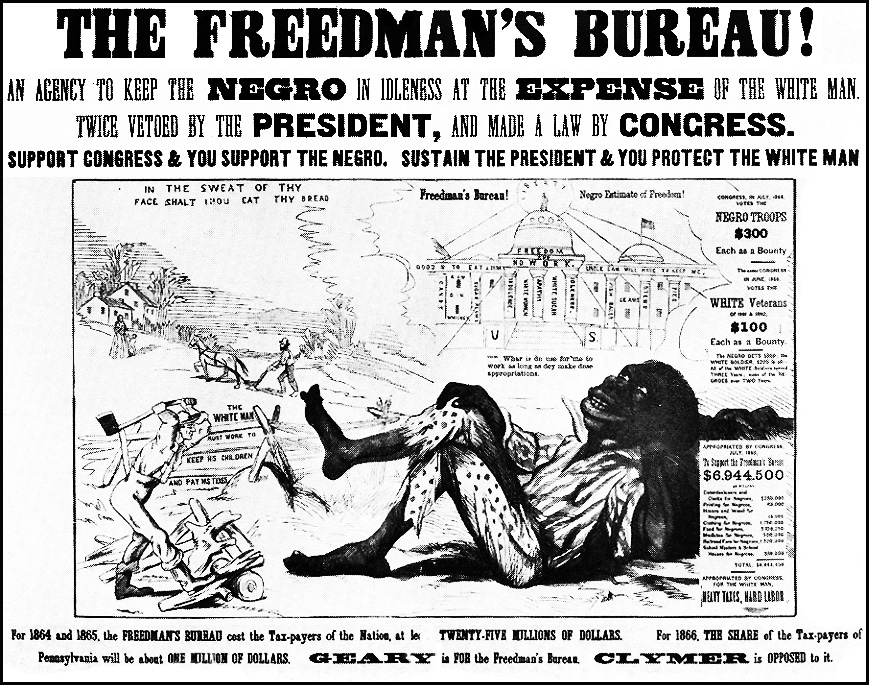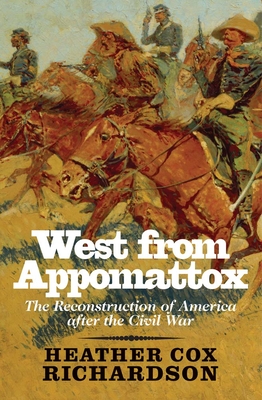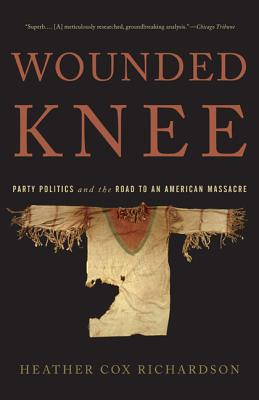American History Chat - April 16, 2020
Link to Video on Facebook
Link to transcript provided by Rana Olk

Having set up the “American paradox” in previous chats, today Heather discussed the period of
Reconstruction, with the ascent of Andrew Johnson after the death of Lincoln, Johnson's generally lenient
policies towards the South, violence in the South after the civil war, the appearance of “black codes” and
the establishment of the Freedmen's bureau.
During this period, in the South, there was a change in justification for the war from a “defense of
slavery” to that of “states’ rights”. Fears about taxes leading to redistribution of income to blacks and
immigrants took hold, and were exacerbated by news about the Paris commune. Attempts of the government to
develop programs for social welfare led to accusations of ‘communism’. At the same time, a myth was
developing in the West, that of the ‘cowboy’. Underlying this myth was a continuing legacy of racial
hierarchies.
Links (underlined) related to topics covered in the chat
“Cornerstone” Speech, Alexander H. Stephens -March 21, 1861
The competing principles of North and South were not only the preserve of political leaders
The Declaration of Causes of Seceding States
QUOTE: South Carolina, Mississippi, Texas, and Georgia issued “Declarations of Causes” along with their Ordinances of Secession. These documents, published in the winter of 1860-1, offer thorough explanations of the factors which compelled the states towards disunion.
Slavery, Not States' Rights, Caused Civil War Whose Political Effects Linger
QUOTE: When you go back and you look at the actual documents, many people have said since then that it was about states' rights, but really the only significant state right that people were arguing about in 1860 was the right to own what was known as slave property — property and slaves unimpeded — and to be able to travel with that property anywhere that you wanted to. So it's clear that this was really about slavery in almost every significant way, but we've sort of pushed that to the side because of course we want to believe that our country is a country that's always stood for freedom. And ... certainly it's difficult for some Southern Americans to accept that their ancestors fought a war on behalf of slavery. And I think that Northerners really, for the cause of national reconciliation, decided to push that aside — decided to accept Southerners' denials or demurrals.
Robert E Lee Surrender
On this day, Confederate General Robert E. Lee agreed to surrender his Army of Northern Virginia, marking a symbolic end to the Civil War on April 9, 1865.
ANDREW JOHNSON: LIFE BEFORE THE PRESIDENCY
QUOTE: Although he owned a handful of slaves and had supported the Democratic Party’s proslavery agenda before the war, Johnson gradually came to support emancipation as a war measure—a means to punish the Confederate elite and rob them of resources.
The Former Slaves of Andrew Johnson
QUOTE: Johnson’s close association with Abraham Lincoln, as both his vice president and his successor, often disguises Johnson’s own slave ownership. He is a complicated example of a southerner who simultaneously supported the Union and gradual emancipation while perpetuating slavery through the bondage of others—perhaps even fathering children with his enslaved servant. Some of these enslaved individuals were later freed and brought to work at the White House during the Johnson administration. While Andrew Johnson was loyal to the North and pompously referred to himself as the “Moses of the colored men,” his legacy, largely measured by his mishandling of Reconstruction politics after the assassination of Abraham Lincoln, remains marred by racial prejudice.
Johnson Vetoes on 1866
During Johnson's presidency, Congress tried to pass two major bills. The Freedman's Bureau Bill and the Civil Right's Bill of 1866. By this time, Johnson was rather unpopular with the North due to his leniency with the South and his rather racist beliefs. Part of the reason Johnson reacted so strongly to these two bills is because Johnson, like Andrew Jackson, was a strong supporter of states rights. These two bills not only refuted his own ideals that African Americans didn't deserve the rights they were given but also asserted federal power over the states. Unfortunately for Johnson, both bills ended up passing.
Veto of the Civil Rights Bill Andrew Johnson | March 27, 1866
This is Johnson's statement at the time of the 1866 veto (which was eventually over-ridden) that includes many of the themes highlighted in today's chat related to racial hierarchies
Violence in the South after the Civil War
Violence swept across parts of the South in the aftermath of the Civil War, reflecting the immense tensions created by the end of slavery and Confederate defeat, and white Southerners' determined resistance to blacks' quest for autonomy.
African American Records: Freedmen's Bureau
National Archives site on the Freedmen’s Bureau.
The Freedmen’s Bureau
A classic article written by W.E.B. Du Bois in 1901.
Southern Black Codes
QUOTE: White Southerners resented being ruled by Union military governors and Freedmen’s Bureau officials. They sought to restore self-rule. During the summer and fall of 1865, most of the old Confederate states held constitutional conventions. President Johnson’s reconstruction plan permitted only white persons to vote for convention delegates or to participate in the framing of the new state governments. Not surprisingly, none of the state conventions considered extending the right to vote to the freedmen. South Carolina’s provisional governor declared at his state constitutional convention that “this is a white man’s government.”

How a Difficult, Racist, Stubborn President Was Removed From Power—If Not From Office
QUOTE: He routinely called blacks inferior. He bluntly stated that no matter how much progress they made, they must remain so. He openly called critics disloyal, even treasonous. He liberally threw insults like candy during public speeches. He rudely ignored answers he didn’t like. He regularly put other people into positions they didn’t want to be in, then blamed them when things went sour. His own bodyguard later called him “destined to conflict,” a man who “found it impossible to conciliate or temporize.”
The Battle Over Reconstruction
QUOTE: From 1863 until his death, President Abraham Lincoln took a moderate position on Reconstruction of the South and proposed plans to bring the South back into the Union as quickly and easily as possible. During this time, the Radical Republicans used Congress to block Lincoln’s moderate approach. They sought to impose harsh terms on the South, thinking Lincoln’s approach too lenient, as well as to upgrade the rights of freedmen (former slaves). The moderate position, held both by Lincoln and Vice President Andrew Johnson (who took over the presidency after Lincoln’s death), prevailed until the election of 1866, at which point the Radicals were able to take control of policy, remove former Confederates from power, and enfranchise the freedmen. A Republican coalition came to power in nearly all of the Southern states and set out to transform the society by setting up a free-labor economy, with support from the army and the Freedmen’s Bureau.
Grant, Reconstruction, and the KKK
QUOTE: At the time of Ulysses S. Grant's election to the presidency, white supremacists were conducting a reign of terror throughout the South. In outright defiance of the Republican-led federal government, Southern Democrats formed organizations that violently intimidated blacks and Republicans who tried to win political power. The most prominent of these, the Ku Klux Klan, was formed in Pulaski, Tennessee, in 1865. Originally founded as a social club for former Confederate soldiers, the Klan evolved into a terrorist organization. It would be responsible for thousands of deaths, and would help to weaken the political power of Southern blacks and Republicans.

For some years, the University of South Carolina Beaufort (USCB) has been hosting three-week summer institutes for k-12 teachers, where they discuss and write essays about the period of reconstruction. Output from these is available here . The virtual essays, in particular, are quick reads and feature many pictures and other figures that help to illustrate historical developments
Taxpayer's Conventions in 1871, 1874
QUOTE: In 1871 and 1874 white Democrats in South Carolina, frustrated with high taxes and the Republicans’ domination of the state government, held statewide conventions to register their protests. The 1871 convention met in Columbia to protest that year’s tax increase to the unheard-of level of eleven mills on the dollar.
Introduction to 19th-Century Socialism
This is one of the many guides written by Professor Paul Brians of Washington State University for his students, which he has made available to the non-university community.
The Fires of Paris
QUOTE: The Paris Commune of 1871 was one of the four great traumas that shaped modern France. It stands alongside the 1789 Revolution, the ascent of Vichy, in 1940, and (odd though it seems, given how nonviolent and small-scale they were) the Events of May, 1968.
Impact of Paris Commune in the United States
QUOTE: The Paris Commune had international significance, and therein lay its historical importance. In all countries of the western world it had numerous vilifiers as well as defenders. In the United States the chorus of abuse grew crescendo-like. Calumny of the Parisians became a pattern of thought.
The O'Leary Legend
QUOTE: Mrs. O'Leary offered a far better scapegoat. While she herself may or may not have been at fault, what she represented was a more acceptable cause for the fire than the Communard. Unlike him, she was a familiar and recognizable type who could readily be made to stand for careless building, sloppy conduct, and a shiftless immigrant underclass. Blaming her adapted existing anti-Catholic, anti-immigrant, and possibly anti-female sentiments to the terrible calamity at hand in a way that was oddly comforting.
RANCHING
QUOTE: During the Civil War Texas furnished beef to the Confederacy until the summer of 1863, when federal armies closed the Mississippi River to traffic. Cattle multiplied until they were estimated at eight per capita of the population. Unbranded cattle by the thousands roamed the range (see MAVERICKS). At the end of the war, steaks and roasts were selling in eastern markets at twenty-five to thirty cents a pound, while a mature, fat Texas steer could be bought for six to ten dollars. The same steer was worth thirty or forty dollars at the end of the trail. Texas was cattle rich, but the way to market was through storms, across swollen rivers, and into hostile Indian country. In 1866 Texas trail herds began marching to Montana gold mines, New Mexico Indian reservations, and Kansas railheads
Charles Goodnight – Blazing the Cattle Trails
QUOTE: Co-founder of the Goodnight-Loving Trail, Charles Goodnight was born in Macoupin County, Illinois on March 5, 1836. Charles moved with his family to Waco, Texas in 1846 when he was ten years old. By the time he was 20, he was working as a cowboy and served with the local militia in the many fights against Comanche raiders. In 1857, he joined the Texas Rangers, where he continued to fight in the Indian Wars and served as an Indian scout. Later, when the Civil War began, he again served as a scout. After the war, Goodnight joined up with Oliver Loving to move cattle from Fort Belknap, Texas to Fort Sumner, New Mexico, in what became known as the Goodnight-Loving Trail.
The Myth of the Cowboy Way
QUOTE: THE TALL, RUGGED FRONTIERSMAN AND NOBLE KNIGHT-ERRANT ROAMING THE OPEN RANGE IS LARGELY A FIGMENT OF OUR COLLECTIVE IMAGINATION. In reality, the typical cowboy on the American frontier was not the Marlboro Man but, as historian David T. Courtwright says, “a hired hand with a borrowed horse, a mean streak and syphilis.” He was also young — age 24 on average — and exceedingly dirty, wore ill-fitting garments and was on the small side so as to be light in the saddle. If he worked with cattle, he was known as a “cowhand” or a “waddy,” the derogatory “cowboy” reserved for drunkards and thieves (though many cowhands certainly qualified as both).
The War and Westward Expansion
With Federal resources focused on waging the war farther east, both native tribes and the Confederacy attempted to claim or reclaim lands west of the Mississippi. The Federal government responded with measures (Homestead Act, transcontinental railroad) and military campaigns designed to encourage settlement, solidify Union control of the trans-Mississippi West, and further marginalize the physical and cultural presence of tribes native to the West.
Civil War in the West
QUOTE: Put simply, one cannot understand the Civil War without addressing the significance of the West in American history before, during, and after the traditional chronology of the war. And likewise you cannot understand the West without taking into account changes wrought by the nation’s cataclysmic Civil War. Though often held apart, the histories of the Civil War, Reconstruction and the American West compose a larger, unified history of conflict over land, labor, rights, citizenship and the limits of governmental authority in the United States.
How a Court Answered a Forgotten Question of Slavery’s Legacy
QUOTE: Slavery was a reality of indigenous life in the Americas prior to the arrival of Africans and Europeans. As Christina Snyder explains in her book Slavery in Indian Country: The Changing Face of Captivity in Early America, “captivity” was “widespread, and it took many forms.” But, as Snyder explains in tracing the history of Southern Indian captivity to the pre-Columbian era, the advent of European colonialism meant that Indians found themselves thrust into a global economy underscored by a racialized system of human trafficking for profit. “Slavery was not peculiar to indigenous societies,” where captives were prisoners of war obtained from enemy tribes, Snyder notes, but “the [commodified] form that slavery took in the antebellum South and elsewhere in the colonial Americas,” was new.
Sherman Writes to His Brother Concerning The Plains Indians
QUOTE: On September 23, 1868 General William T. Sherman wrote to his brother Senator John Sherman from the headquarters of the Military Division of Missouri. In his letter Sherman discussed the ensuing struggles between the United States Army and the Plains Indians and expressed some of his thoughts on how best to deal with the situation. Many of these thoughts appear to point to one thing: Total War
A Brief History of the Bozeman Trail
Gold Fever! The '49ers were among the first in the West to be infected with that contagion when they took the California Trail to the goldfields of the Sierra Nevada. Next were men like John Merin Bozeman who came to Colorado in the Pikes Peak gold rush, which began in 1859 and lasted throughout the early 1860s.
Bozeman Trail War — 1866
QUOTE: Fetterman, a Civil War veteran had previously boasted “With eighty men I could ride through the Sioux nation.” That December day he would have his chance. The rescue party rode out and Indian decoys drew the soldiers over Lodge Trail Ridge and into a trap. Red Cloud and his warriors, one thousand strong, rose up from the tall grass and all of Fetterman’s troops died. Fetterman and Capt Frederick Brown assisted each other in committing suicide rather than face capture and torture by the amassed Sioux and Arapaho warriors.
How the 1867 Medicine Lodge Treaty Changed the Plains Indian Tribes Forever
QUOTE: By the early 20th century, life on reservations was similar to life in the homelands of apartheid South Africa—people had no freedom of movement, they had no freedom of religion. Basically all their rights were taken away,” Gilman says. “But in 1867, nobody knew that was going to happen
Two Nations Made a Treaty, the U.S. Broke It and Plains Indian Tribes are Still Seeking Justice
QUOTE: In 1868, the United States entered into the treaty with a collective of Native American bands historically known as the Sioux (Dakota, Lakota and Nakota) and Arapaho. The treaty established the Great Sioux Reservation, a large swath of lands west of the Missouri River. It also designated the Black Hills as “unceded Indian Territory” for the exclusive use of native peoples. But when gold was found in the Black Hills, the United States reneged on the agreement, redrawing the boundaries of the treaty, and confining the Sioux people—traditionally nomadic hunters—to a farming lifestyle on the reservation. It was a blatant abrogation that has been at the center of legal debate ever since.
Birth of a Birthright
QUOTE: Some called the immigrants an “unarmed invasion.” And those weren’t just words. Armed vigilantes attacked Chinese immigrants. In 1871, a Los Angeles crowd killed 17 by hanging, in what has been called the largest mass lynching in American history. In 1882, Congress passed the Chinese Exclusion Act. The law prohibited Chinese people from being naturalized as citizens, creating a permanent class of aliens on racial lines. The first federal immigration restriction based on race, it laid the groundwork for the first large-scale deportation of immigrants in U.S. history. But much to the dismay of Wise and other white supremacists, none of that stopped Chinese people from trying to build new lives in America.





